

What, you may be asking, are Pop-pop Pages? This is a Big Deal about a little toy, a toy that has fascinated everyone from children to physicists for one hundred years. The idea here is to arouse your interest, give you some project ideas and techniques, and provide a place for pop-pop enthusiasts to share their passion.What is a "pop-pop" boat?
Pop-pop boats are powered by a simple boiler consisting of a thin coiled tube of copper. The tube's ends extend out the back of the boat into the water. The coils in the middle of the tube extend over a small flame, which heats the water in the coils. When the water boils, the steam jets out the back, propelling the boat forward. It's that simple.There is one form of propulsion for small toy boats that does not use a conventional engine. It is nevertheless a true heat engine ... Boats fitted with these simple devices are variously known as flash-steamers, hot-air-boats, toc-tocs (after a German version in the 1920s) or pop-pops. A more accurate term for the 'motors' is Pulsating Water Engine (P.W.E.) since that is what they are. Basil Harley, Toyshop Steam, Argus Books, 1978
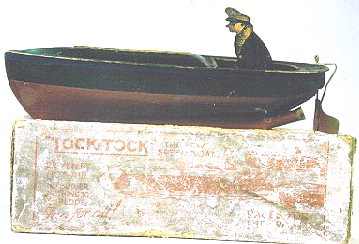
Photo courtesy Gasoline Alley Antiques. Note single-tube boiler!A slightly more sophisticated version substitutes a little shallow chamber with a flexible diaphragm for the coil. The flexing of the diaphragm gives a little more impulse to the escaping steam, as well as making a louder pop.
Some History
Basil Harley seems to have rediscovered the 1891 invention of the pop-pop boat about 1982, after having written several articles on pop-pops for Model Boats magazine during the 1970s. In a 1975 article, Harley mentions a similar boat seen in a French journal from 1880. The pop-pop boat as we know it originated in an 1891 British patent for water pulse engines by an inventor named Thomas Piot. The patented engine was of the coil type.
The popularity of the boats spread quickly, however, and they were soon being manufactured in many countries. In Toyshop Steam, Harley mentions a series of boats made in the first decade of the 20th century by the German toymakers Ernst Planck. In 1916 a US patent was granted to Charles McHugh for the diaphragm type engine. (See patent document.) The McHugh patent was specified for use in toys, while the Piot patent was apparently left more general. The addition of the diaphragm seems to have produced a toy with great appeal, as evidenced by the large number of advertisements found in magazines such as Popular Science and Boy's Life (see illustration). The German name for the boat, toc-toc, originated as a product brand name for a diaphragm-boilered boat in the late 1920's, while they have also been called put-put, phut-phut, and pouet-pouet boats elsewhere.
How do they work?
Ahh, the Big Question! John Gwynn wrote in Model Engineer, "It is amazing how much interest is generated by such a humble scientific toy. Perhaps this can in part be attributed to the mystery that surrounds just how such a bafflingly simple device manages to function at all!"The practical answer to the question is fairly simple: "A small flame boils water in a very narrow tube so that it expands into steam. The expansion of the steam pushes the water out the tube at the back of the boat, and the boat moves forward in response to the jet of steam. After expansion, the steam cools enough to create a partial vacuum which refills the tube with water, and the cycle begins again." The simple explanation has some holes, however, when viewed from a physicist's point of view. Dr. Dick Crane, writing in The Physics Teacher, has done a very accessible analysis of the physics and engineering issues of the pop-pop boiler. His column "How Things Work" is reprinted here by permission of the American Association of Physics Teachers.
In The Flying Circus of Physics, Jearl Walker pinpoints the crucial quality that makes the pop-pop boiler function:
The candle converts some of the water in the boiler to steam, which then pushes the water column back through the tube to emerge behind the boat in a jet. Upon leaving the boiler, some of the steam condenses in the cooler tube and contracts, thereby pulling water back into the tube. However, the key feature is that the water entering the tube comes from a hemisphere of directions, not from a single direction. There is a net propulsion forward because of the asymmetry in the jet emission rearward and the inflow from all directions in the rear hemisphere.If all this sounds hopelessly arcane, Gordon Read points out in Model Engineer (Oct. 1996, p. 374) that pop-pop boats "are like model hovercraft in that it's difficult to make one that won't work. But making an efficient one is an entirely different matter!"
The pop-pop "coil boiler" is a boiler in its most primitive form. The engineering term for this kind of apparatus is a "flash boiler", though most engineers think of something much more sophisticated when they hear the term. But even without the technical advances used on "real" flash boilers, the pop-pop still moves under its own power, which is enough for most people.
The key is to have a very small passageway heated to boiling temperature, then introducing water into it. The water boils almost instantaneously ("flashes"), creating a lot of steam pressure in the small space. The expansion of the water into steam is then turned into mechanical motion -- by a cylinder in a machine such as a Stanley Steamer automobile, or by simple Newtonian action/reaction in the case of the pop-pop boat.

A more efficient boiler is the diaphragm type. This variant replaces the coils with a small metal pan whose top is a slightly concave piece of very thin, springy metal such as brass shim. The diaphragm has two apparent effects when the steam flashes under it: first, it makes a click sound to augment the quiet pup-pup-pup of the coil boiler; second, as it pops up and then back into its original shape, it may impart some more concentrated energy to the exhaust jet. The result is a boat which runs well and makes a vaguely motor-like noise.Matt Welland has made a full-size drawing of a commercial boat made in India, showing the arrangement of the diaphragm boiler as well as the general construction of the boat.
How are they made?
Making a pop-pop boat is utterly simple. I first learned the concept from my Wolf Cub Scout book, in a project called a "Jet Boat". According to the archivist at Boy Scout headquarters, the Cub Scout book contained this project from 1954 through 1977. John de Treville found a plan in a Cub Scouting handbook dated 1948. Two generations of Scouts, raised on pop-pop boats!All you have to do to make one is wind a piece of small-diameter copper tubing into a coil, and stick it into something with a boat-like shape. (Derek Pratt's article in Model Engineer showed boats made from oval herring tins.) Put a flame under the coil, and you have a pop-pop boat. To run the boat, fill the tube with water and light the flame. Soon, the tube will get hot enough to boil the water, and you'll hear it make the characteristic pup-pup-pup sound that gave the boats their name.
The Pop-pop Pages is pleased to present an advanced construction article in which Marc Horovitz gives detailed instructions on how to build your own metal pop-pop boat. (A slightly simpler, but less effective, design is here.)
You can see an colorful variant of Horovitz' design at Uwe's Junkyard.
In the meantime, you can make a simple "jet" boat out of balsa or pine, based on the Cub Scout Handbook design. I made mine from balsa, and later covered it in aluminum flashing tape from a home-improvement store for water-proofing. I used two pieces of 1/4 inch (6mm) thick balsa. From the top piece, I cut out the inside of the hull with a scroll saw. I glued the two pieces together with waterproof wood glue, cut the point of the bow on the saw, and then drilled the tube holes at an angle in the back transom of the boat.
The tube is 1/8 inch (3mm) diameter copper, widely available in hobby and auto parts stores. I wound the tube with two turns around a 1 inch (25mm) dowel. (Pulling on the tubing while bending may help prevent crimping.)
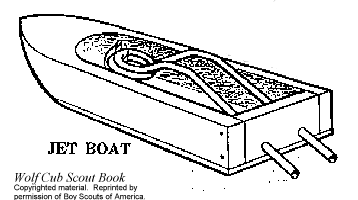
For a burner, I took a rectangular piece of brass sheet, cut square pieces out of the corners, and folded the sides up to make a shallow tray. I soldered the joints between the sides to keep the fuel from leaking out. (Use silver solder or 2% silver-bearing solder. The 2% can still be worked with an ordinary soldering gun, and may be found in electronics supply stores.) A tray of this type is suitable for burning sterno jelly or the Esbit tablets sold for toy steam engines (both are alcohol-based). Candles do not appear to work with this design; they simply don't put out enough heat.
To build a boat with a diaphragm-type boiler, get a copy of Model Engineer magazine, 5 January 1996. In it you will find Derek Pratt's excellent article on building these boats from herring tins and other preformed metal parts. (For example, The pop-out lid from a cocoa tin, or similar, is used for the body of the boiler.)
Or, have a look at this excellent web site: Slater Harrison's Science Toys. The author, a teacher whose students have built hundreds of these boats, has developed a very simple and unique design. His boats can be made with almost no metal parts. HIn addition to excellent instructions and innovative designs, Harrison has posted historical and instructional videos on YouTube. Definitely check this one out!
John Woodson, at the other extreme, made his own metal-forming tools to produce a small run of these gorgeous models of the famous '40s racing boat Miss England. (Click on the photo to see more at Woodson's web site.) His boat features twin keels w/integrated rudders, high-efficiency exhaust nozzles, functioning condenser/solid state bilge pump, and an improved burner. Not to mention the hand-made mahogany storage box.
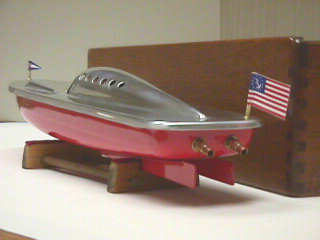
And then there is Peter R. Payne, whose interest in the engineering aspects of the water pulse-jet led him to some fascinating experimentation using them in full-sized boats. If you want to take your construction project to the leading edge of the technology, Payne's work is the handbook for your efforts.
A surprise sighting.
Japanese animator Hiyao Miyazaki has used quirky "retro" technology in many of his films, but of special interest to us here is Ponyo (2008). The main (land-based) character has a pop-pop boat that he's fond of, and during a crisis, it grows large enough for two children to ride in! A pop-pop boat is said to have been a favorite toy of Miyazaki, when he was a child.
Of course, the boat was also produced as a tie-in toy (now, sadly, sold out). It's a good-sized boat - it sppears to be about 6 inches (15cm) long. So, a toy insipires a film, which inspires a toy! Here's a video (in Japanese) showing it in action; the shots of the diaphragm are particularly good, showing just how much flexion there is: http://www.youtube.com/watch?v=MMyCPE6IhQk
Where can you learn more?
Books
Harley, Basil. Toyshop Steam. Argus Books, 1978.Walker, Jearl. The Flying Circus of Physics John Wiley & Sons, 1977.Articles
Baker, J. G., "Self-Induced Vibrations", Transactions of the American Society of Mechanical Engineers, 55, APM-55-2 (1933), pp. 5-13.Chaddock, D.H. "Toc-Toc Boats", Journal of SMEE, Jan 1991, Vol. 7, no. 1, p. 10.Churchill, Toby. "PopPops. The search for Power", Model Boats Nov. 1987, pp. 610-14. (Includes plans.)Crane, Richard. "How Things Work: the Pop-Pop Boat", The Physics Teacher, Mar. 1997, Vol. 35, Number 3. pp. 176-177. (Also reprinted in Model Engineer, 26 Sept. 1997, p. 402.)
Deadman, David. "Popette", Model Boats Feb. 1986, pp. 82-3. (Includes plans.)de la Taille, Renaud. "Le Bateau à Réaction", Science et Jeux, Physique amusante Science et Vie, no. 839Finnie, I. and R. L. Curl. "Physics in a Toy Boat", Amer. Journ. Phys. 1963, vol. 31, p. 289.Gollwitzer, Hans. "Das Kerzenboot", Machinen im Modellbau date unknown.Hardy, Michael. "Making a Pop-Pop", Model Boats, March 1986, pp 128-130. (Includes plans.)Harley, Basil. "Flash Steam Propulsion", Model Boats, February 1976, pp. 69-71.Harley, Basil. "More on Pop-pops", Model Boats, February 1976, p. 96.
Harley, Basil. "Basil Harley reflects on Pop-pops", Model Boats, January 1979, p. 44.
Harley, Basil. "Traditional Steam Engines -- Steam Pulse Jets", Model Boats, January 1982, p. 27.
Harley, Basil. "Marine Miscellany -- Pulse Jets (Pop-pops to their friends)", Model Boats, p. 373.
Harley, Basil. "The Steam Pulsejet Centenary", The Newcomen Bulletin No. 149, April 1991.
Harley, Basil. "The Steam Water Pulse Jet Centenary", Journal of SMEE, July 1991, Vol. 7, no. 2.Harley, Basil. "Steam Water Pulse Jet Centenary", Model Boat, June, 1992, Vol. 44, no. 496.Harrison, Victor. "Steam plants for small scale model steamers", The Model Engineer and Light Machinery Review, June 21, 1928, pp. 583-4.B.C.J. "Boat Propulsion. Some Notes on an Old but Little Used Method.", The Model Engineer and Electrician, June 8, 1922, pp. 548-50.
Mackay, R.S., "Boat Driven by Thermal Oscillations", American Journal of Physics, 26, 583 (1958).Matthews, Jack "Pop-pop Boats", Model Boats November, 1995.Memin, Rudy. "Râ mon premier bateau à vapeur", L'escarbille No. 38.Miller, J. S., "Physics in a Toy Boat", American Journal of Physics, 26, 199 (1958).Note: The following entries by the late Peter R. Payne must be seen to be believed. They are certainly the most comprehensive engineering testing of the water pulsejet engine ever done, including investigations into the pulsejet's applicability to full-sized boats.Midson, S.T. "P-P-Pop-Pop Power!", Model Boats, April 1987, pp. 212-3.
I am indebted to Earl Wildes for finding these articles and sharing them with the Pop-pop Pages and to Payne's son, Graeme, for filling in the bibliographic information on the articles and informing me of the patents.Payne, Peter R. "A New Steam Cycle Engine", Proceedings of the Ninth
Intersociety Energy Conversion Engineering Conference (IECEC), San
Francisco, California. August 1974.Payne, Peter R. "A Progress Report on the Water Pulsejet", Proceedings of
the Tenth Intersociety Energy Conversion Engineering Conference (IECEC),
Newark, Delaware. August, 1975.Payne, Peter R. "Recent Developments with the Water Pulsejet", Proceedings
of the Thirteenth Intersociety Energy Conversion Engineering Conference
(IECEC), San Diego, California. August, 1978.Payne, Peter R. "Engine with No Moving Parts", Chemtech; January ,1975
Payne, Peter R. "Intermittent Propulsors - An Overview", Marine Propulsion, Volume II. Proceedings of the Winter Annual Meeting of the American Society of Mechanical Engineers (ASME). New York, New York. December 1976.
Payne, Peter R. "Heat engine in the form of a water pulse-jet"; US Patent 3,898,800, August 1975.
Payne, Peter R. "Pulse-jet Water Propulsor"; US Patent 4,057,961, November, 1977.
Pratt, Derek. "Water Pulse Jets", Model Engineer, 5 January 1996 (vol. 176), p. 53.
Retif, Bernard. "Connaissez vous les Pouet-Pouet", Modèle Réduit de BateuSatow, Michael. "Phut Phut", Journal of SMEE 1 Jan. 1991, Vol. 7, no. 1, p. 11.Stevens, Len. "Exploring Pop Pop Pulse Propulsion", Model Boats February, 1995.Stroud, John. "Pop-Pop Steam Engines -- Pop-Pop Paddle Steamer -- The Wesel", Model Maker, November 1980.Wagner, Joe. "Alki", Model Boats January 1970, p. 20.Wells, K.G. "This simple jet boat is always popular", Model Engineer 15 August 1963.Wells, K. "Model Jet Boat", Woodworker February 1969.Various authors. "Post Bag", (letters to editor) Model Engineer, 4 October 1996 (vol. 176), p. 374. Letters from three correspondents, plus a follow-up from Derek Pratt.Organizations
l'Association des Amis des Moteurs Pop-Pop (AAMPP)
La Droguerie du Marine
66 Rue George Clémenceau
35400 Saint Servan sur Mer
FranceThis group, organized in 1992, has some 200 members.
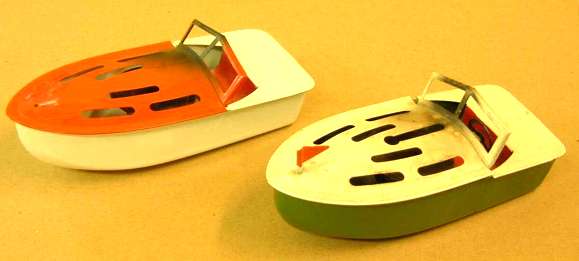
A sharp-looking pair of Swedish boats from the 1950s, made by POD of Stockholm.

Another rare and interesting boat from Argentina.
Of course, there's an online discussion group for pop-pop boat fans!
Where can you buy one?
The topic of pop-pop boats hit the Internet late in 1996 when some of the participants of a live steam on-line discussion group found some boats which had been recently made in India. This led to a surprising amount of discussion -- it seems that pop-pop boats were a very popular toy forty or fifty years ago, and almost everyone over 50 either had one or remembers them fondly.The revival continued as many sources for new pop-pops, primarily from India (photo) and China, were uncovered. Collector Robin Corsiglia has many good pictures of the boats he's collected, and a large number of the sources below come from his research.
Buying and trading with other collectors is, of course, a common way to get into the collecting side of a hobby. Robin Corsiglia has been exploiting the net in his search for boats and other collectors. Another collector's web site with a lot of interesting pop-pop pictures is http://www.buzzboats.com, Buzz's Boatyard. (Both collectors also sell and trade boats.)As the trend has apparently blossomed, I have been receiving a surprising number of mail-order catalogues which include the ubiquitous Indian or Chinese boats, usually at inflated prices. So many, in fact, that I have stopped trying to record every one of them here. What follows is a list of what I consider the sellers of quality or unique boats, and the pioneers -- those who jumped on a good thing as soon as they saw it, rather than waiting to see which way the winds of fashion would blow. We know which way these winds blow!A list of this sort changes often, by its nature. Please e-mail me if you find errors or have updates to the list.
Where do all these boats come from? The tin toy manufacturers of Europe and North American are virtually extinct. In India, however, the art of pressing toys from tin-plated steel is still alive and flourishing. If you wish to become an importer or dealer of pop-pop boats, here are two manufacturer/exporters from India.

Rattandeep EnterpriseRattandeep Enterprise
MB-111 Master Block
Shakkarpur
Delhi 110092
India
Fax : 91-11-2231526
e-mail: rattandeepenterprise@vsnl.com
Web site: http://www.angelfire.com/extreme2/rattandeepenterpriseRattandeep Enterprise is the manufacturer and exporter of many of the boats we see today, such as the well-known speedboats, tug boats, and the impressive Titanic. Their latest creations are the 10-inch "Super Tugboat" and "Thunder Cruiser", said to have the largest boiler of any boat now made. The owner of Rattandeep is justifiably proud that the factory does not use child labor or indentured labor. The boats are all made by craftsmen using hand-presses. There are fascinating photos of the hand-operated machinery on the Rattandeep Enterprise web site.
Welby Impex Pvt Ltd.
Welby Impex Pvt Ltd.
57, Toy City
Greater Noida
U.P. 201306
India
Tel: 91-(0) 9811087919, 91-(0) 120-2350919, 3092122
Fax: 91-(0)120-2351100
e-mail: welby@vsnl.com
web: http://www.welby.inAnother source of hand-assembled boats from India is Welby Impex, who are manufacturers and exporters of pop-pop boats as well as numerous other great tin toys. Their boats are also available in Europe, as they take part in the Nurnberg Toy fair every year.
Featherlite Boats
Featherlite Boats, now sold out, were handmade in a limited quantity from aluminum and brass in the US. The manufacturer sold directly to customers. They were somewhat more expensive than imported boats, but their handmade, limited nature gives them collectible appeal.
Tucher+Walther
Raiffeisenstr. 3
D-91448 Emskirchen GERMANY
tel.: 49 9104 3390
fax: 49 9104 3302

Tucher+Walther produce some enchanting, and often very costly, tin toys. Some are made from tooling salvaged from German tin-toy makers of the 1920s and 30s, others are handmade modern work. Tucher+Walther's wonderful steamboats fall into the handmade category. Some are clockwork, some have "traditional" steam engines, others are pop-pop steam powered. They are made in limited editions and may or may not be available at any given time. T+W will apparently only sell directly in quantity, but you can get them one at a time in the US through The Great Toy Steam Company, Lilliput Tin Toys or Scheffels Toys. Inquire about availability.Retail sources are numerous now; the list below is partial -- you'll find pop-pop boats available in many hobby shops and mail-order catalogues. Here is a selected list of retail dealers:
American Science & Surplus
3605 Howard Street
Skokie, IL 60076
tel.: 847-982-0870
web site: http://www.sciplus.com/
AS&S carry the ubiquitous olive-oil boat, which seems to have replaced a really nice boat they used to carry with a wick-type alcohol burner. (Search for "steam boat".)Buzz' Boatyard
Buzz McMillian has a wide selection of toy boats: pop-pop, wind-up, new and antiques. Web site includes MPEG movies of some of the boats in action -- cool!
e-mail: buzz@buzzboats.com
Web site: http://www.buzzboats.comToys by John Červenka
John Červenka has been producing hand-made tin toys since 1980. He makes a wide a delightful range of toys, but boats are a stated specialty. The web page is not the easiest to navigate, but it's worth searching out the boats to see his wide range - everything from small launches to pop-pop battleships and ocean liners.
e-mail: johncervenka34@msn.com
web site: http://www.toysbycervenka.com/
Andy Curle
Blennerhasset Mill
Blennerhasset, Carlisle
Cumbria CA5 3QQ ENGLANDGasoline Alley Antiques
6501 20th Ave NE
Seattle, WA 98115-6943
tel.: 206-524-1606
fax: 206-524-6343
e-mail: vintage@gasolinealleyantiques.com
web site: http://www.gasolinealleyantiques.com/nautical.htm
Gasoline Alley has a richly stocked nautical toys department, often including antique pop-pop boats (the photo of the German "Tock-Tock" boat in the history above is from their collection).Goodfriends Försäljning AB
Goodfriends are the Scandinavian importers for Rattandeep's line of pop-pop boats (no sales to individuals, however).
e-mail: kristinasandstrom@telia.com
web: http://www.goodfriends.nu/Graham Family Enterprises
P.O. Box 129
Bellingham, WA 98227 USA
tel.: 877-663-4090
e-mail: pjggraham@yahoo.com
Importers for Rattandeep's line of boats, they carry many different kinds of Indian-made boats: the basic motorboat, a really cool "streamlined" ferry, a tugboat (now a larger model than their original tug), and the incredible 15-inch long Titanic. Dealer packages are available for retail stores.Tony Green Steam Models
Tony Green sells a variety of steam toys, including a sturdy-looking modular pop-pop engine that looks like a vertical steam boiler. It resembles and may well be Unit Steam's ready-made coil motor..
e-mail: sales@tonygreensteammodels.co.uk
web site: http://www.tonygreensteammodels.co.uk/acatalog/Pop_Pop_Engines.html
Home on the Farm
39 Macquarie St.
Monan, SA 5169
AUSTRALIA
Telephone/fax: 61-8-83273039
web site: http://www.geocities.com/eisemanntrading/
e-mail: eisemann @ chariot.net.au
Home on the Farm manufacture a conventional pressed-tin runabout type boat, which is available ready-to-run and as a science kit. They also distribute a wonderful "gunboat" hand-made by a craftsman in the Philippines (click photo, right, for a larger view). The runabout kit is AU$16, ready-made AU$18. The gunship is AU$25. Add AU$12 for express air mail worldwide (AU$5 in Aus/NZ).
Home on the Farm also distribute other tin toys and a fantastic Stirling-powered table fan. You have to see this one to believe it!Hilgart Holdings
6160 Everson Goshen Rd.
Everson,WA 98247 USA
Order Line: Toll Free (877)966-7158
Fax: (360) 966-7994
web site: http://www.puttputtboats.com/
e-mail: boats@puttputtboats.comJester's
A British shop that sells traditional wooden toys, tin toys, pub games, antique games, Juggling and Magic equipment. They have a good selection of boats from all over the world.
Jesters
65 Oxford Street
Whitstable, Kent. CT5 1DA
United Kingdom
web site: http://jesters.com/acatalog/Tin_toy_boats.html
Richard Johnson
PO Box 27093
6336 E. Prince
Prescott Valley, AZ 86312
tel.: 520-775-4714
Richard has the boats from India and one the same size from China (w/candles) that is fully lithographed.Knatterboot
Jörg Fischer
Alberoweg 6
54295 Trier
GERMANY
Fax: +49 (0)651 4368976
Telefon: +49 (0)651 4368977
e-mail: info@knatterBoot.de
web site: http://www.knatterboot.de/
German company specializing in pop-pop boats. Wholesale dealer for Europe, possibly retail sales as well. Interesting historical and technical material (in German).Lee Valley Tools
PO Box 1780
Ogdensburg, NY 13669-6780
tel.: toll-free 800-871-8158
web site: http://www.leevalley.com (search for "boat")
Lee Valley Tools has the best prices I have seen anywhere on the indian-made 6-inch boats: three for $7.50 (plus shipping).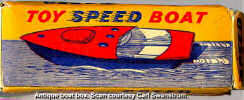
Maritime Models Greenwich
7 Nelson Road
Greenwich
SE 10 London ENGLAND
Tel: 44 181 858 5661Scheffel's Toys
Scheffel's Toys, Inc.
180 W. California
P.O. Box 626
Jacksonville, OR 97530
tel.: (541) 899-7421
fax: (541) 899-8839
Scheffel's carries fine metal toys from around the world, including Indian pop-pop boats and (sometimes) Tucher+Walther's wonderful folk-art boats (pop-pop, clockwork and live steam. The inventory seems to vary, so they may or may not have a pop-pop at any given time.) If you're not familiar with T+W's boats, by all means have a look at Scheffel's web page: http://www.scheffels.com/collecti.htm
SpaceTin.com
SpaceTin specializes in pop-pop boats and and tinplate robots. They have a very large selection of pop-pop boats and feature online ordering.
http://www.spacetin.com
Unit Steam Engines
Rose Cottage
London Road
Mickleham
Surrey RH5 6EH ENGLAND
tel.: 44 372 378075
Offer engines (US$12) and a wooden Mississippi Steam Boat Kit for US$16.John Woodson
e-mail: jw@stanleysteamers.com
web site: http://www.stanleysteamers.com/phantomboats/photos.htm
Offers a spectacular, 15-inch hand-built boat, an upgraded replica of the 1950s "Miss England", for $360 plus shipping.
If you find a new source for pop-pop boats, I'd like to know of it. Just drop me a note.
(You will have to edit the "To:" line in your e-mail. Sorry about this, but the spam is killing me.)

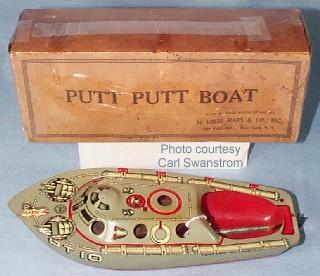 The
Pop-pop Pages are copyright
© 1997-2010 Vance
Bass.
They may not be
reproduced without permission.
The
Pop-pop Pages are copyright
© 1997-2010 Vance
Bass.
They may not be
reproduced without permission.
Thanks to the Pop-pop Pages contributors (listed alphabetically): Boy Scouts of America, Toby Churchill (Model Boats author and experimenter), Robin Corsiglia (collector extraordinaire), Dr. Richard Crane (Univ. of Michigan) & the AAPT, John Gwynn & Prof. Jean Le Bot (AAMPP, France), Ron Brown (ed., Steam in the Garden), Slater Harrison, Marc Horovitz (SitG author and editor of Garden Railways), Bill Joy, Buzz McMillian, Graeme C. Payne, Rainer Radow, Carl Swanstrom, Dave Sweet, Rakesh Thukral (Rattandeep Enterprise), Ben Truwe, Anders Tyndal, Matt Welland, John Woodson and all of you who have sent in pop-pop boat sighting reports and dealer information..
Last updated: 17 Dec. 2012
![]() Visit
the Small-Scale
Live Steam Resources
site.
Visit
the Small-Scale
Live Steam Resources
site.